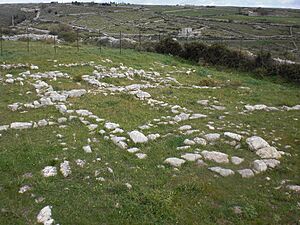Sicels facts for kids
The Sicels (pronounced SIK-əlz or SISS-əlz) were an ancient tribe. They lived in eastern Sicily during the Iron Age. Sicily is an island that got its name from them! The Sicels spoke a language called Siculian.
After a big battle called the Battle of Nomae in 450 BCE, the Sicels were defeated. Their leader, Ducetius, died ten years later. After this, their state broke apart. Their culture slowly blended with the Greek culture that was growing in Sicily.
Contents
History of the Sicels
Archaeologists have found signs that ancient Greek culture influenced Sicily during the Bronze Age. The first time the Sicels are mentioned in writing is in the famous Greek story, the Odyssey. The writer Homer also talked about the Sicani, another group in Sicily. For Homer, these groups seemed very similar.
Historians think the Sicels and Sicani might have been people from the Illyrian region. They may have moved into Sicily and mixed with the people already living there. Ancient writers like Thucydides believed the Sicels once lived in central Italy. They were pushed out by other tribes and eventually crossed into Sicily.
The Sicels likely arrived on the island around 1000 BC. They brought new things like iron tools and domesticated horses. Some experts think the name "Sicel" might be even older. It could be linked to the "Shekelesh," one of the mysterious Sea Peoples. These Sea Peoples attacked Egypt around 1200 BC.
The most famous burial ground (or necropolis) of the Sicels is Pantalica, near Syracuse. Another large one is Cassibile, near Noto. Their special tombs were shaped like ovens or beehives.
Sicel Towns
Some of the main Sicel towns were:
- Agyrium (now Agira)
- Centuripa (now Centuripe)
- Henna (now Enna)
- Three towns named Hybla: Hybla Major, Hybla Minor, and Hybla Heraea.
When Greek colonists arrived in Sicily, things changed for the Sicels. Some Greeks, like the Chalcidians, got along well with the Sicels. But others, like the Dorians, did not. The Sicels were pushed away from the best port areas. They slowly moved further inland, away from the coast.
In one town called Morgantina, Sicels and Greeks lived together. Historians still debate if it was a Greek city or a Sicel city. Greek goods, especially pottery, became popular among the Sicels. Over time, Greek culture started to influence Sicel town planning.
Ducetius and the Sicel State
In the mid-400s BC, a Sicel leader named Ducetius tried to unite the Sicel towns. He created an organized Sicel state to stand against the powerful Greek city of Syracuse. His state included several cities in central and southern Sicily.
After a few years, in 450 BC, Ducetius's army was defeated by the Greeks in the Battle of Nomae. He died ten years later. Without his strong leadership, the Sicel movement fell apart. The Sicel culture became more and more like Greek culture.
However, some Sicels later joined forces with Athens against Syracuse. This shows that not all Sicels were happy with Greek rule.
Some evidence suggests that the Sicels had some customs where women held more power. This was unusual for other groups in the region at that time.
Sicel Language
Experts believe the Sicels spoke an Indo-European language. They lived in eastern Sicily and southern Italy. Other groups in Sicily, like the Elymi and Sicani, lived in western and central parts. The Sicani likely spoke a different, non-Indo-European language. The Elymian language is thought to be Indo-European, possibly related to Latin.
We know very little about the Sicel language. We have only a few words from ancient writers and a handful of inscriptions. It seems the Sicels did not write until they learned from the Greek colonists.
Several Sicel inscriptions have been found. One long inscription was found on a jug in 1824. It uses a Greek alphabet from the 6th or 5th century BC. It reads:
- "nunustentimimarustainamiemitomestiduromnanepos duromiemtomestiveliomnedemponitantomeredesuino brtome…"
Another long inscription was found in Montagna di Marzo:
- "tamuraabesakedqoiaveseurumakesagepipokedlutimbe levopomanatesemaidarnakeibureitamomiaetiurela"
These inscriptions are very hard to understand.
One strong clue that Sicel was an Indo-European language is the word pibe, meaning "drink." This word is very similar to the Latin word bibe, which also means "drink." Some ancient writers even said that Sicel was very similar to Latin. Many Sicel words sounded almost the same as Latin words and had the same meaning.
Sicel Religion
The Sicels had a special cult that worshipped twin gods called the Palici. Their story was influenced by Greek myths. In the story, a local nymph (nature spirit) named Talia had twin sons with Adranus. Adranus was a god of volcanoes, whom the Greeks linked to their god Hephaestus.
The story says that the twins were "twice-born." They were born first from their nymph mother. Then, because the goddess Hera was jealous, she made Mother Earth (Gaia) swallow the nymph. The ground then split open, and the twins were born again from the earth. The Sicels honored these twins as protectors of sailing and farming.
At the temple of Adranus, the father of the Palici, the Sicels kept an eternal fire burning. There was also a god or goddess named Hybla (or Hyblaea). Three towns were named after this deity.
The Greek gods Demeter and Kore were linked to the town of Enna. The nymph Arethusa was linked to Syracuse. These connections show how Greek religion influenced the Sicels.
See also
- Ancient peoples of Italy
- Ancient Italic peoples
- Italiotes
- Prehistoric Italy
- Siceliotes
- Sea Peoples
- Sicani


